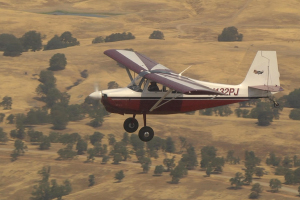PG&E begins daily aerial patrols to spot wildfires
PG&E/James Green
SAN FRANCISCO — Pacific Gas and Electric Company (PG&E) has begun daily aerial fire detection patrols across hundreds of miles of its service area to assist the U.S. Forest Service, CAL FIRE and local fire agencies with early fire detection and response this summer.
PG&E is launching the patrols this week due to an increase in fire danger from rising temperatures, coupled with the potential for winds. The patrols also will occur in time for the Independence Day holiday with its risk of fires sparked by illegal or misuse of “Safe and Sane” fireworks.
“Even though the drought emergency has been lifted in most California counties, the wet winter resulted in a significant grass crop. That, with 102 million dead trees in our forests, is a potentially dangerous combination. We all must remain vigilant this summer when it comes to wildfire prevention and preparation,” said Kevin Dasso, PG&E vice president of Electric Asset Management.
The patrols will run until October 31, unless conditions allow for an earlier end. Five planes will fly daily routes from late afternoon until dusk, when wildfires are most likely to ignite with hot, dry weather at its peak.
Using fixed-wing aircraft, fire spotters will operate along these routes:
- Redding to Auburn in the Northern Sierra
- Auburn to Auberry in the Southern Sierra
- Redding to Humboldt to Lake County
- Vacaville to Solvang near the coast
- Mendocino County
The patrols are coordinated through PG&E’s aerial operations. The Mendocino County route is co-funded by PG&E and run by the Mendocino County Aerial Fire Patrol Co-Operative. The Co-Op patrol will begin July 1 and run through October 15.
In 2016, the third year of the patrols, PG&E and Mendocino Co-Op planes spotted 142 fires, and in seven instances, PG&E was first to report the fires to CAL FIRE or the U.S. Forest Service. Early detection of smoke or fire allows fire agencies to quickly respond to accurate locations to put out fires before they spread.
“CAL FIRE has responded to over 1,700 wildfires since January 1, 2017 that have resulted in more than 18,000 acres burned across California,” said Chief Joe Tyler, CAL FIRE’s assistant deputy director of fire protection. “We appreciate the aerial patrols PG&E does to look for potential fire starts, especially in those areas most impacted by the unprecedented tree mortality.”
PG&E funds the patrols as part of its ongoing response to California’s tree mortality emergency caused by years of drought and bark beetle infestation. In addition to its daily aerial fire patrols, PG&E is conducting enhanced ground patrols on 73,000 miles of electric power line to inspect and remove dead and dying trees that could fall into a line and cause a fire. PG&E provided $2 million to local Fire Safe Councils this year to fund 43 fuel reduction projects in 21 counties. The company is also supporting CAL FIRE’s public education campaign to help raise and drive awareness of fire risk, prevention and response.
Dead trees are an extreme fire danger because they allow wildfires to spread rapidly. If you have dead or dying trees on your property, the entire tree needs to be removed.
Contact PG&E at 1-800-743-5000 or online at www.pge.com/treesanddrought before removing dead trees near power lines. You can learn more about bark beetle and how to remove dead trees on your property through CAL FIRE’s www.ReadyforWildfire.org.


